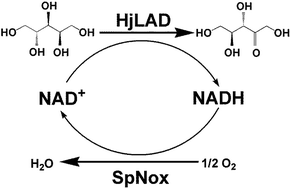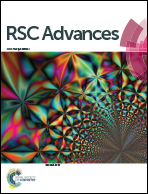Rare sugar production by coupling of NADH oxidase and l-arabinitol dehydrogenase†
Abstract
An efficient biocatalytic cell-free system containing L-arabinitol dehydrogenase (LAD) for L-arabinitol oxidation and NADH oxidase (Nox) for cofactor regeneration was successfully constructed and used for L-rare sugar production. The recombinant LAD (HjLAD) from Hypocrea jecorina suffered from NADH inhibition. Applying Nox to the cell-free HjLAD system drove the thermodynamically unfavorable equilibrium from L-arabinitol to L-xylulose, along with the regeneration of the oxidized cofactor NAD+. Response surface methodology was used to optimize the conditions for L-xylulose production. The optimal conditions for biocatalytic production of L-xylulose were found to be 4.9 U mL−1 HjLAD, 8.2 mM NAD+ at pH 8.0, and 30.9 °C; a high conversion rate of 78.4% was achieved under these conditions. We demonstrate a cell-free enzyme coupling system enabling efficient cofactor recycling and providing high yields of L-xylulose. The results indicate that this coupling system provides a new biocatalytic method for L-rare sugar production.


 Please wait while we load your content...
Please wait while we load your content...